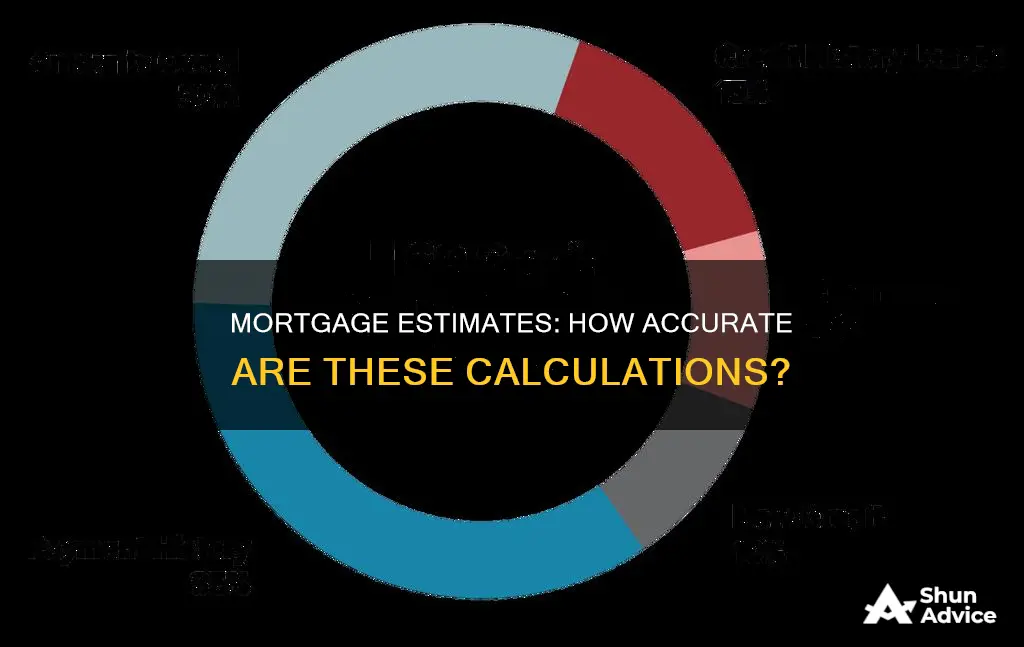
A mortgage estimate, or loan estimate, is a three-page document that outlines the terms and projected costs of a mortgage. It includes details such as the interest rate, upfront loan costs, monthly payments, and closing costs. The accuracy of a mortgage estimate depends on the information provided by the borrower. While it is not a guarantee of approval, it gives borrowers an idea of what to expect in terms of loan costs and enables them to compare offers from different lenders.
| Characteristics | Values |
|---|---|
| Name of the document | Loan Estimate (LE) or Good Faith Estimate |
| Number of pages | 3 |
| Purpose | To provide important details about a mortgage loan, including terms, projected costs, interest rate, upfront loan costs, monthly payments, and a breakdown of closing costs |
| When received | Within 3 business days of applying for a mortgage |
| Accuracy | Depends on the details provided by the borrower; more detailed information results in a more accurate estimate |
| Comparison | Can be compared side-by-side with other loan estimates to find the best rates and fees |
| Binding | Valid and binding for 10 days from issuance; lenders must honour the interest rate offer |
What You'll Learn

Loan Estimate vs Good Faith Estimate
A Loan Estimate (LE) is a standard document that outlines the terms, costs, and fees associated with a mortgage loan. It is provided by the lender to the borrower and includes information such as the loan amount, interest rate, upfront costs, monthly payments, and closing costs. LEs follow a uniform format, making it easy to compare offers from different lenders.
Prior to 2015, a Good Faith Estimate (GFE) was used instead of a Loan Estimate. A GFE is a document that outlines the basic terms and estimated costs of a reverse mortgage loan. It was replaced by the Loan Estimate to simplify the process and make it more transparent for borrowers.
One key difference between a Loan Estimate and a Good Faith Estimate is their scope. A Loan Estimate covers all the costs associated with buying a home, even those not directly related to the mortgage, such as property taxes and insurance. On the other hand, a Good Faith Estimate primarily focuses on the costs and terms specific to the reverse mortgage loan.
Another distinction is in their level of detail. A Loan Estimate provides a comprehensive breakdown of costs, including those that vary across lenders and those that are fixed. It also includes projections for future payments and comparisons to other mortgage options. In contrast, a Good Faith Estimate offers a more general overview of the loan's costs and terms.
While a Loan Estimate is not a guaranteed quote, it represents the lender's best effort to provide accurate information. Lenders are required to issue Loan Estimates within three days of receiving a complete loan application. The terms outlined in the Loan Estimate are typically binding, and lenders cannot change their costs or fees without valid reasons.
Mortgage Surveys: Accurate or Fiction?
You may want to see also

How to compare mortgage estimates
A mortgage loan estimate is a standardised three-page document from a lender that outlines the details of a mortgage. It includes information such as the type and terms of the mortgage, as well as projected costs. The document is designed to help borrowers understand the complete cost of their mortgage and make it easier to compare loan offers.
- Get multiple loan estimates: Request loan estimates from multiple lenders to compare rates and fees. This will allow you to find the most competitive offer for your needs.
- Review the details: Make sure to carefully review the details of each loan estimate, including the loan term, purpose, product, loan type, loan amount, monthly payments, and estimated closing costs. Ensure that the information matches what you discussed with the lender and that there are no inaccuracies.
- Compare origination charges: Origination charges are upfront fees charged by the lender for initiating the mortgage. Compare these charges across different lenders to understand the true cost of the loan.
- Consider other costs: In addition to origination charges, there may be other costs associated with the loan, such as services required by the lender. Review the "Services You Cannot Shop For" and "Services You Can Shop For" sections of the loan estimate to understand these additional costs.
- Calculate the five-year cost: On page three of the loan estimate, there is information about how much you will have paid altogether and how much you will have paid off toward the loan balance in five years. This can help you understand the short-term costs, especially if you don't plan to stay in the house for a long time.
- Negotiate: Don't be afraid to negotiate with lenders. Having loan estimates from other lenders can be a bargaining chip, as lenders may be willing to match or beat their competitors' offers.
- Research lenders: In addition to comparing rates and fees, take the time to research lenders by reading online reviews and ratings. This can give you valuable information about their customer service, responsiveness to concerns, and competitiveness of their rates.
Mortgage Pre-Approvals: Are They Reliable?
You may want to see also

What a Loan Estimate includes
A Loan Estimate is a standardised three-page document that you receive after applying for a mortgage. It contains important details about the loan you have requested. Lenders are required by law to provide you with a Loan Estimate within three business days of receiving your application. The form uses clear language and design to help you understand the terms of the mortgage loan you've applied for.
The first page of the Loan Estimate includes a summary of your loan. This section includes the loan term, purpose, and product. The loan term is the number of years it will take you to pay off the mortgage. The purpose is whether the loan will be used to purchase or refinance a home. The product is whether the mortgage has a fixed or adjustable interest rate.
The second page of the Loan Estimate itemises the loan's closing costs and shows how much cash you'll need to finalise the loan. Closing costs are expenses paid by buyers and sellers before a real estate transaction is finalised. These expenses are in addition to the purchase price of the property and can range from 3% to 6% of the purchase price. They typically include fees such as application fees, attorneys' fees, credit report fees, homeowners' insurance, inspection fees, title search fees, and underwriting fees.
The third page of the Loan Estimate provides a detailed breakdown of your projected monthly payments. This includes the estimated total monthly payment, which is the sum of the components that make up your regular mortgage payments. It also includes information on whether your loan includes a prepayment penalty or a balloon payment and which expenses are included in your escrow account. A prepayment penalty means that the lender can charge you a fee if you pay off your mortgage early. A balloon payment means that the final mortgage payment is a large lump sum, often much higher than regular monthly payments.
Trulia Mortgage Estimates: How Reliable Are They?
You may want to see also

How to read a Loan Estimate
A Loan Estimate is a standardised, three-page document from a lender that details the terms of a mortgage offer. It includes the type and terms of the loan, as well as projected costs. It is important to note that the information in the document is not final, but it helps borrowers compare offers and budget appropriately. Here are some key points on how to read and understand a Loan Estimate:
Understanding the Basics
The Loan Estimate provides important details about the mortgage, such as the loan term, purpose, product, and loan type, as well as the loan amount. Make sure these match what you discussed with the lender and your expectations. Check for any additional charges included in your payments, such as property taxes, homeowners' insurance, or other assessments.
Projected Payments and Interest Rates
The Loan Estimate will outline the projected monthly payments, including taxes, insurance, and escrow, if applicable. Pay close attention to the interest rate being offered. Lenders may offer a fixed or adjustable interest rate. If the interest rate is adjustable, your Loan Estimate will have additional information in the Projected Payments table and additional tables at the bottom of the document.
Closing Costs and Cash to Close
The Loan Estimate will detail the estimated closing costs, which are the fees you'll need to pay at the end of the mortgage process. These costs can include items such as origination charges, appraisal fees, and other services. Additionally, the Loan Estimate will provide information on the Calculating cash to close section, which includes the estimated down payment and the total closing costs. This is the full amount of cash you'll need to have on hand when closing the mortgage.
Comparing Offers and Finalising the Loan
It is recommended to apply with multiple lenders and compare their Loan Estimates line by line to determine the best deal. Pay close attention to differences in interest rates, origination charges, and points. Compare the bottom line of the estimated monthly payments and cash to close. Once you've chosen a lender, you'll go through the full mortgage underwriting process, and the lender will provide a Closing Disclosure with the final terms and costs of your loan. Review this document carefully and compare it to the Loan Estimate to ensure all the information matches.

What to do after receiving a Loan Estimate
A Loan Estimate (LE) is a standard, three-page document that outlines important details about a mortgage loan you have requested. It includes information such as the interest rate, upfront loan costs, monthly payments, and a breakdown of closing costs. While receiving a Loan Estimate does not guarantee approval of your mortgage application, it shows the loan terms the lender expects to offer if you decide to proceed. Here are some key steps and considerations to keep in mind after receiving a Loan Estimate:
Review the Details:
Check that the Loan Estimate reflects what you discussed with the lender. Verify that the loan amount, loan term, interest rate, and monthly payments align with your expectations. Ensure your personal information, such as your name and contact details, is accurate. Even minor discrepancies can lead to issues down the line.
Compare Offers:
Obtain Loan Estimates from multiple lenders to facilitate comparison. LEs follow a uniform format, making it straightforward to compare rates, fees, and terms across different lenders. This process ensures you get the most competitive offer and helps you understand the costs and features associated with the loan.
Understand the Costs:
Review the Loan Estimate to identify all applicable costs, including origination charges, closing costs, taxes, insurance, and any additional fees. Ensure you understand which services are required by the lender and which you can shop for separately to potentially save money. Ask questions about anything unclear and request clarification if certain costs differ from your expectations.
Look for Special Features:
Pay attention to special features or conditions of the loan, such as prepayment penalties or negative amortization. Negative amortization refers to situations where the mortgage loan balance may increase even if timely payments are made. Understanding these features is crucial for managing your loan effectively.
Provide Additional Information:
If you decide to proceed with the loan, the lender will request additional financial information to complete the underwriting process. Be prepared to provide documentation supporting your income, savings, debt, and ability to repay the loan.
Stay Vigilant with Mortgage Rates:
Mortgage rates fluctuate daily, and locking in your rate is essential to avoid unexpected changes. If you are considering multiple loan options, submit your applications simultaneously to ensure you are comparing the most current rates. Remember that shorter-term mortgages typically offer lower rates but require higher monthly payments.
Frequently asked questions
A mortgage estimate, or loan estimate, is a three-page document that outlines the terms and projected costs of a mortgage loan you have applied for. It includes details such as the interest rate, upfront loan costs, monthly payments, and closing costs.
A mortgage estimate is an initial indication of what loan terms a lender expects to offer and is subject to change. The more details you provide, the more accurate the estimate will be. It is important to review the estimate and compare it with other lenders' offers to ensure you get the best deal.
To obtain a mortgage estimate, you must provide the lender with your name, income amount, Social Security number, and the address of the property you wish to purchase, along with its estimated value and the requested loan amount.
A mortgage estimate is typically valid for a period of 10 days from issuance, provided there are no major changes to the loan or application.







